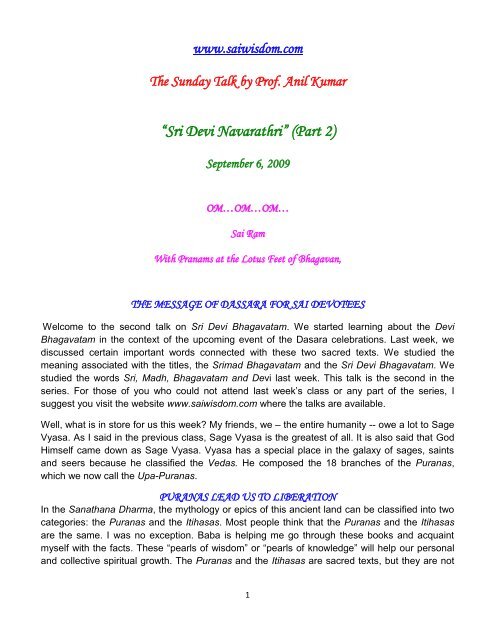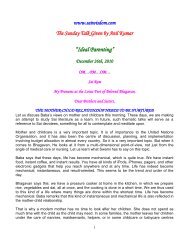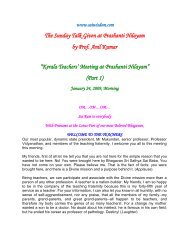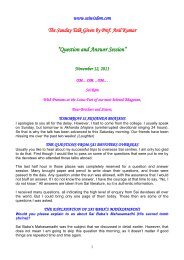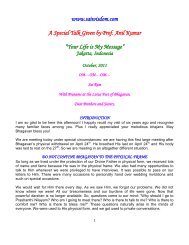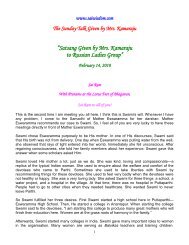PDF - The Sunday Talk Given by Anil Kumar - Sai Wisdom
PDF - The Sunday Talk Given by Anil Kumar - Sai Wisdom
PDF - The Sunday Talk Given by Anil Kumar - Sai Wisdom
You also want an ePaper? Increase the reach of your titles
YUMPU automatically turns print PDFs into web optimized ePapers that Google loves.
www.saiwisdom.com<br />
<strong>The</strong> <strong>Sunday</strong> <strong>Talk</strong> <strong>by</strong> Prof. <strong>Anil</strong> <strong>Kumar</strong><br />
“Sri Devi Navarathri” (Part 2)<br />
September 6, 2009<br />
OM…OM…OM…<br />
<strong>Sai</strong> Ram<br />
With Pranams at the Lotus Feet of Bhagavan,<br />
THE MESSAGE OF DASSARA FOR SAI DEVOTEES<br />
Welcome to the second talk on Sri Devi Bhagavatam. We started learning about the Devi<br />
Bhagavatam in the context of the upcoming event of the Dasara celebrations. Last week, we<br />
discussed certain important words connected with these two sacred texts. We studied the<br />
meaning associated with the titles, the Srimad Bhagavatam and the Sri Devi Bhagavatam. We<br />
studied the words Sri, Madh, Bhagavatam and Devi last week. This talk is the second in the<br />
series. For those of you who could not attend last week‘s class or any part of the series, I<br />
suggest you visit the website www.saiwisdom.com where the talks are available.<br />
Well, what is in store for us this week? My friends, we – the entire humanity -- owe a lot to Sage<br />
Vyasa. As I said in the previous class, Sage Vyasa is the greatest of all. It is also said that God<br />
Himself came down as Sage Vyasa. Vyasa has a special place in the galaxy of sages, saints<br />
and seers because he classified the Vedas. He composed the 18 branches of the Puranas,<br />
which we now call the Upa-Puranas.<br />
PURANAS LEAD US TO LIBERATION<br />
In the Sanathana Dharma, the mythology or epics of this ancient land can be classified into two<br />
categories: the Puranas and the Itihasas. Most people think that the Puranas and the Itihasas<br />
are the same. I was no exception. Baba is helping me go through these books and acquaint<br />
myself with the facts. <strong>The</strong>se ―pearls of wisdom‖ or ―pearls of knowledge‖ will help our personal<br />
and collective spiritual growth. <strong>The</strong> Puranas and the Itihasas are sacred texts, but they are not<br />
1
the same. <strong>The</strong> Puranas will lead us to liberation, or nirvana or moksha. Almost all epics come<br />
under the category of the Puranas, and will lead us to moksha or liberation.<br />
ITIHASAS TEACH US MORAL CONDUCT OF LIFE<br />
<strong>The</strong> second branch or division comes under the Itihasas. What are the Itihasas? <strong>The</strong> Itihasas<br />
guide us along the path of righteousness. <strong>The</strong>refore, while the Puranas take us towards<br />
liberation, the Itihasas teach us how to lead a dharmic life. Most of the texts are Puranas, but<br />
there are only two Itihasas that tell us about the moral conduct of life. <strong>The</strong> Ramayana and the<br />
Mahabharata are the only two texts that come under the category of Itihasas which speak about<br />
the dharmic way of life. <strong>The</strong> rest of the books comprise the Puranas, which lead us towards<br />
liberation or moksha.<br />
WE DO NOT KNOW THE SIGNIFICANCE OF FESTIVALS AND RITUALS<br />
Bhagavan had said at one time, when explaining the idea of His Divinity and agenda:<br />
Kaala Sandhigdha Nigraha Deepthulai Unda<br />
Bhaashyardha Guptamul Paluku Koraku<br />
Kaala Sandhigdha Nigraha Deepthulai Unda<br />
Today, society is in confusion. People interpret things as they would like to see them. This is<br />
convenient philosophy. We don‘t understand the correct meaning or depth of the matter, so we<br />
forget about following that which is actually conveyed. We do not know the real inner<br />
significance of important festivals and rituals.<br />
<strong>The</strong>re are only two possibilities in modern society: (a) forget about everything else because we<br />
don‘t want to investigate anything—life is only about eating, drinking and sleeping, or (b)<br />
become a fanatic or a blind follower: we keep doing something without knowing or<br />
understanding why. Others are doing this, therefore we follow blindly. This is due to our lack of<br />
understanding of the inner significance of all spiritual activities, rituals and texts.<br />
THE MEANING OF FESTIVALS AND RITUALS HAS THREE DIMENSIONS<br />
Bhagavan has said:<br />
Bhaashyardha Guptamul Paluku Koraku.<br />
I have come down in human form to explain to you the inner significance of all the festivals and<br />
rituals.<br />
It is a pity if you do not benefit from Him. When God Himself has taken pity on us, if He cannot<br />
help us to elevate ourselves in any way, in spite of repeatedly telling us (because we refuse to<br />
listen), we have to blame ourselves later for not understanding these things. And then it will be<br />
too late. During this precious time that we have with Him, let us be aware of what He wants to<br />
convey.<br />
2
<strong>The</strong> inner meaning can be classified under three headings. (I am a teacher, you must<br />
have guessed <strong>by</strong> now.):<br />
1. Adi Bhouthika<br />
2. Adi Daivika<br />
3. Adi Adhyatmika<br />
<strong>The</strong>se are the three types, three dimensions, or three perspectives of all the inner significance<br />
or the inner meanings most mercifully conveyed to us <strong>by</strong> Bhagavan Baba.<br />
What do you mean <strong>by</strong> Adi Bhouthika? Swami gives one interpretation of this.<br />
In fact, I was very tempted to say to Swami, ―Swami, I want to speak on Onam (a Kerala<br />
festival).‖ But it looks awful because I have been speaking on that topic since the year 1978!<br />
Swami may ask me, ―Are you not tired?‖ Or He may say, ―Enough is enough!‖ What will happen<br />
next? <strong>The</strong>n He may advise, ―You have been speaking on this for 30 years! Why don‘t you start<br />
living it? What is this?‖<br />
Well, thinking of all these possibilities, I forced myself to sit down. Swami explains Onam and its<br />
significance so wonderfully. So, I decided to forget about speaking on Onam.<br />
So, the interpretation of Adi Bhouthika is: speak softly while leading a comfortable life along the<br />
path of righteousness (dharma). In other words, <strong>by</strong> leading a righteous life, we can be happy.<br />
This is the first perspective or interpretation.<br />
<strong>The</strong> second perspective is Adi Daivika, which means: with faith in God, lead a dharmic way of<br />
life so that you‘ll be happy. Dharma, with faith in Him, is the path that results in happiness.<br />
<strong>The</strong> third category, perspective, or dimension is Adi Adhyatmika, which means: we are no<br />
longer victims of duality. We are beyond pleasure and pain. This means we have grown beyond<br />
the mind, because pleasure and pain are in the mind, not in the body. We know that it is the<br />
mind that is responsible for pain and pleasure. So Adi Adhyatmika means ‗going beyond the<br />
mind‘, no longer affected <strong>by</strong> pleasure, pain, profit, loss, fortune, misfortune, victory and defeat.<br />
You are not at all affected. This is purely a spiritual dimension and is called Adi Adhyatmika or<br />
leading life in a righteous way such that we will be happy.<br />
Finally, my friends, the inner significance or the interpretation of Bhagavan Sri Sathya <strong>Sai</strong> Baba<br />
on other nomenclature, meaning the spiritual technical terms observed in some festival rituals,<br />
fall under three headings:<br />
1. Adi Bhouthika, meaning dharmic way of life<br />
2. Adi Daivika, meaning dharmic way of life with full faith in God<br />
3
3. Adi Adhyatmika: dharmic way of life with full faith in God, going beyond the state of<br />
duality, beyond the mind.<br />
<strong>The</strong>se are the three dimensions through which Baba explains the inner significance of<br />
everything. As we read His literature, as we try to dive into the depths of what we read, we are<br />
lost in ecstasy and forget ourselves. If anyone is unable to forget themselves as they listen to<br />
Him or read His literature, it means that they are still hopeless. It means that they are still<br />
pinned down to their desires and body attachment. This is a very pitiable situation. <strong>The</strong> act of<br />
getting lost as we hear Him, or of forgetting ourselves when we read His works, is indeed Adi<br />
Adhyatmika, a spiritual experience.<br />
<strong>The</strong> Vedas are the ancient scriptures of Sanathana Dharma. <strong>The</strong>y have their own branches<br />
called Vedaangaas. Anga means ‗limb‘ or ‗a branch‘. Vedaangaa means branches of the<br />
Vedas. <strong>The</strong> Vedaangaas are the most ancient texts which are not written but are heard. <strong>The</strong>y<br />
are recapitulated and passed down from one generation to another.<br />
NAVARATHRI REPRESENTS COMING OUT OF DARKNESS OF IGNORANCE<br />
Navarathri celebrations begin from 19 September. Nava means ‗nine‘, rathri means ‗night‘. So,<br />
‗Navarathri‘ means ‗nine nights‘. Night is about darkness, which represents ignorance.<br />
Navarathri is about coming out of the darkness of ignorance <strong>by</strong> turning on the light within you.<br />
Where is the darkness? Darkness is within the mind and the light is in my heart. What<br />
happened? <strong>The</strong> mind is not directed towards the torchlight.<br />
When the camera is facing you, you should turn towards the lens. If I turn my back on the lens,<br />
I can‘t expect to see the face. <strong>The</strong>refore my friends, there is light within me, but the mind goes<br />
in the opposite direction; therefore it is dark. Now, when the mind turns towards the light, it is<br />
illuminated; the darkness is dispelled. It is gone once and for all.<br />
WE ARE BORN WITH AWARENESS<br />
Nava also means ‗new‘. <strong>The</strong> light, the illumination, the awareness is new. Prajnana is spiritual<br />
knowledge. Prajnana is that which is original, latent, immanent and hidden in us when we are<br />
born. Prajnana need not be taught. What does that mean? I know I am a human being,<br />
correct? Nobody needs to teach that.<br />
Who helps you to go to sleep? I do not know. In sleep, I forgot everything, but when I woke up,<br />
I remembered that yesterday you refused to look at me (Laughter). Who made you remember<br />
all that happened yesterday? Who took you to sleep, who woke you up? How do you<br />
remember things, how do you forget things? This is all the natural prajnana. Did anybody teach<br />
us what is sweet, what is hot? I know about taste. My friends, we know all these things. We are<br />
all born with an awareness of the sense of touch, smell, sound, taste, the process of thinking,<br />
the memory. All this constitutes prajnana or awareness and they are all within us. <strong>The</strong>refore,<br />
that prajnana or awareness is the light.<br />
4
NAVRATRI IS ABOUT APPEALING TO OUR MIND TO TURN INWARDS<br />
But unfortunately, the mind wants to be in the dark. If I close all the windows and turn off the<br />
fans and say there is no breeze or light here, what will you say? That I am a fool! ―Why don‘t<br />
you switch on the fan and open the windows?‖ Similarly, when the mind is dark, there is the<br />
darkness of ignorance. What do you tell your mind? ―Oh mind, you are so stupid! You‘ve made<br />
me equally stupid. So, oh mind, I want you to turn inward where there is light or prajnana within<br />
you.‖<br />
Dhiyoyonah Prachodayat<br />
Tamasoma Jyothirgamaya<br />
Sabko Sanmati Do Bhagavan<br />
This is a prayer for the mind because we are able to control everything except our mind. If<br />
anyone says that he can control the mind, then he does not know much about the mind<br />
because it is almost impossible to control the mind.<br />
<strong>The</strong>refore my friends, Navarathri is a celebration which helps us to dispel the darkness <strong>by</strong><br />
appealing to our mind to turn inwards where there is the prajnana, the awareness, the latent<br />
wisdom with which we are born.<br />
NAVARATHRI FESTIVAL OCCURS TWICE A YEAR<br />
Now this Navarathri celebration for nine nights (rathri: night, nava: nine) happens twice a year.<br />
Students here may say, ―Sir, we only get a vacation for one and not for the other.‖ Forget about<br />
vacation.<br />
<strong>The</strong> Navarathri festival takes place twice. <strong>The</strong> first one is Vasantha Navarathri. <strong>The</strong> second one<br />
is Sharan Navarathri. One takes place from the Telugu New Year to Sri Rama Navami. <strong>The</strong><br />
other takes place during Dassara time. Just like every month has a name such as January,<br />
February and so on, the Hindu calendar too has names. <strong>The</strong> month during which the Vasantha<br />
Navarathri celebration takes place is Chaitra, whereas the Dasara period or Sharan<br />
Navarathri–the upcoming Navarathri this month--is called Ashwayuja.<br />
―Sir, why twice? We are already bored with one!‖ Most household people will be interested to<br />
know because these festivals involve a lot of preparations at home. As Baba mentioned the<br />
other day, the Onam festival is filled with preparations. <strong>The</strong>re are 11 types of payasam and a<br />
lot of new clothes. It is all very good. Why not 90 days? Why only nine days? <strong>The</strong>re is a point to<br />
all this.<br />
<strong>The</strong> first one, Vasantha Navarathri, which takes place during the Chaitra month, gives us one<br />
approach towards God or mukthi or liberation. <strong>The</strong> second one, Sharan Navarathri, or Dasara<br />
during Ashwayuja month shows us another path towards liberation or moksha.<br />
5
ALL PATHS LEAD TO THE SAME GOAL<br />
―Oh, so there are two paths to liberation!‖ Why not? <strong>The</strong>re are many paths, but all paths lead to<br />
the same goal. Baba says that the paths are not contradictory. <strong>The</strong>re is similarity between<br />
them.<br />
In the world, we find different paths, different schools of philosophy, different approaches that<br />
are contradictory, different followers, each claiming to be greater or superior than the other and<br />
this leads to fighting. If we go through history: most wars were fought on the grounds of<br />
religion. What a shame! Religion says that we should love, but we want to kill.<br />
And here is Bhagavan who says that these paths are not different, ideologies are not different.<br />
One leads to another, one adds to the other, one is complementary to another; no one is<br />
contradictory to any other. That is why Bhagavan Sri Sathya <strong>Sai</strong> Baba is most popular today.<br />
His mission is spreading more and more, day <strong>by</strong> day. Why? His approach is one of synthesis<br />
and not one of antithesis. <strong>The</strong>refore my friends, Vasantha Navarathri, which is celebrated in<br />
Chaitra, gives us this perspective. At one time, Baba said: ―Vishala Prapanchamunandu.‖<br />
Kasturiji was the translator and he said, ―In this vast world…‖<br />
Baba said, ―No, no! It is not the world; it is the universe.‖<br />
Prapancha is not the world; it is the universe. Swami beautifully corrects—you must have seen<br />
this. Each correction might be a source of entertainment for you, as we translators fumble and<br />
fail! I am happy too that I can provide some entertainment (Laughter)!<br />
EXPERIENCE THE CREATOR IN THE CREATION<br />
<strong>The</strong> Vasantha Navarathri in Chaitra month gives us one direction. What is that? Baba explains<br />
this:<br />
Viluvaleni Inupa Pette Ee Dehambu<br />
Pette Lona Nagalu Petti Natlu<br />
Dehamandu Atma Devudu Undenu Sumi<br />
Dehamandu Atma Devudu Undenu Sumi-<br />
Satyamaina Mata Ee <strong>Sai</strong> Maata<br />
Viluvaleni Inupa Pette Ee Dehambu<br />
<strong>The</strong> body is like an iron safe which has no value. Iron, after all, has no value.<br />
Pette Lona Nagalu Petti Natlu<br />
6
Inside this iron safe, there is a locker in which we have diamonds, pearls, jewels, necklaces,<br />
chains, earrings, nose studs, etc. So, there is an iron safe which has no value, containing<br />
jewels which are highly valuable.<br />
Dehamandu Atma Devudu Undenu Sumi<br />
<strong>The</strong> body is the iron safe and there are jewels—the consciousness or Divinity—within. That is<br />
the purpose of Vasantha Navarathri. In Vasantha Navarathri, we should be able to explain and<br />
experience the Creator in creation. Further, Bhagavan has also said:<br />
Vishwamandu Veluguchundu Vibhudu Yepudu,<br />
Vibhuni Yandu Vishwam Yepudu Veluguchundu.<br />
It is in God that the universe shines, and the universe is in God .<br />
Vishwavibhula Maîtri Shaashwatambu<br />
Vibhudu Veluga Kunna Vishwambu Velugadhu<br />
Vishwavibhula Maîtri Shaashwatambu.<br />
Unless I have a torch with light, I cannot see in the darkness. Similarly, the creation is here and<br />
the Creator is there; the attachment, the togetherness of the Creator with His creations, is<br />
permanent. Without the Creator, creation cannot shine, cannot function. Am I clear? That is the<br />
significance of Vasantha Navarathri. How beautiful!<br />
CREATION IS THE REFLECTION OF THE CREATOR<br />
At another time, He said:<br />
Idi Gatam Idi<br />
Idi Patam Idi Gruham Idi Aranyam Idi Shailam Idi<br />
Itadu Diwakarudu Itadu Nisaacharudu<br />
Idi Tarakam Idi Grahambulivi.<br />
Those who can understand the Telugu language in this room can appreciate the meaning of<br />
this verse. <strong>The</strong>y will tolerate me because of their devotion to Bhagavan, but no translation of<br />
this verse can ever match the original. Impossible! After all, a translation is a translation. If<br />
anyone thinks that this translation matches the original, bow unto him. Impossible!<br />
Every language has its own beauty. If you translate Tulasidas Ramayan into English, the Hindispeaking<br />
people will not like it. If I try to translate a Shakespeare play into Telugu, it is going to<br />
7
ecome some other thing, not Shakespeare any more. Every language has its own beauty.<br />
Similarly, He says that there are so many articles in this world--a pot, a wall, a mountain, the<br />
stars, the planets, the earth, the ocean, the sea, the wind.<br />
Araya Naakante Bhinnambulai Baahya Padartha Sahitamulella<br />
<strong>The</strong> day and night, stars and galaxies, this entire material world is different from Me . . .<br />
It is outside Me.<br />
Yetti Sadhanamulu Leka Yerangedi<br />
Without any kind of sadhana, I know about the whole universe,<br />
I know what is happening<br />
Saakshinaguchu<br />
I am the witness<br />
Chidrupudunanuchu Yerugarayya<br />
I am that power, that awareness<br />
Understand that I am that power, that awareness. <strong>The</strong> sun knows what sunlight is, the moon<br />
knows what moonlight is, gold knows what glitter is, the flower knows what its smell is, and the<br />
Creator knows the creation because the creation is not separate from Him. Creation is a<br />
reflection of the Creator.<br />
We consider the creation to be separate from the Creator. <strong>The</strong>refore, we have water pollution,<br />
sound pollution, food pollution, soil pollution, nuclear pollution. Everything is polluted; human<br />
life is polluted. We think that creation is material and hence, immaterial to be aware of it. Let us<br />
understand that creation is a reflection of the Creator and creation is as precious, as important,<br />
as holy, as Divine, as spiritual as the Creator Himself. <strong>The</strong>refore my friends, if Vasantha<br />
Navarathri is celebrated during Chaitra month with all the jnana, wisdom or knowledge, then we<br />
should be able to observe the Creator in this creation.<br />
Once, Swami said:<br />
KramamutAppakabaanudu Udayastamayamulanandanela<br />
How do you see day and night? Why not day throughout, or why not night throughout? How do<br />
you see the difference?<br />
Gaganamuna Kanti Kaiseyu Taralu Pagalu Matramu Daagu Bangiyela<br />
8
<strong>The</strong> stars that shine in the night hide themselves during daytime. Why? Why don‘t they shine<br />
during the day also?<br />
Kshanamaina Vishranthi Konaka Taapavanundu Jeeva Kotula Brova Vivenela<br />
Kshanamaina Vishranthi Konaka<br />
Restlessly, without even a moment of rest, the wind blows continuously, and oxygen is supplied<br />
to us.<br />
Jeeva Kotula Brova<br />
Suppose the wind decides, ―Oh Lord, You are not revising my pay, you are not giving me any<br />
promotion, so I want to go on strike tomorrow (Laughter).‖<br />
What will happen? <strong>The</strong> global problem will be solved once and for all. <strong>The</strong>re will be no global<br />
problem at all when the wind god goes on strike. <strong>The</strong>refore, why does the wind god blow<br />
permanently? Why do we find the occurrence of day and night?<br />
Kilakila Navvuthu Dhwanula<br />
Kilakila Navvuthu Dhwanula Nadulu Salilamu Bangi Pravahinchu Chandamela<br />
Stand very close to the river and watch how it flows,<br />
What a beauty it is!<br />
As the river flows and curves and bends round the mountain and down the valley, it makes a<br />
beautiful rhythmic sound. Watch the river flow; there is a tune and rhythm there.<br />
Kilakila Navvuthu<br />
<strong>The</strong> flow of the river is not tragic, melancholic or with a castor oil face like the human being.<br />
<strong>The</strong> river flows ever smilingly, joyfully. <strong>The</strong> flow of the river is a celestial dance, a cosmic<br />
dance. <strong>The</strong> flow of the river is Divine music. Why?<br />
Prakruthi Endu Chusina Bhrama Yela<br />
In this world, there is a lot of illusion everywhere.<br />
9
We want everything, we want to own everything. I want to be a singer, I want to play an<br />
instrument, I want to be a Nobel Prize winner, the president of this country; I want to be the Bill<br />
Gates of this country! Tell me what you don‘t want to be! We want to be everything, we are<br />
attracted <strong>by</strong> everything! We are deluded <strong>by</strong> everything in this world! Why?<br />
Bhoomini Jaati Kula Mata Bhedamela<br />
How do we find so many nationalities and communities in the world?<br />
How? You cannot say these are black, white and yellow. Who is responsible for different<br />
communities, different nationalities, and races?<br />
Athade Ithadu Ani Ithadu Athade Ani<br />
Sarvulaku Adhipathi Ani Kaancharayya<br />
Sarvulaku Adhipathi Ani Kaancharayya.<br />
Understand the Master of the universe, the One who is responsible for day and night, the galaxy<br />
and the stars, the One who makes the rivers, oceans and the lakes flow continuously, rhythmically,<br />
systematically all the time. That Master is verily standing in front of you.<br />
This is what Baba says:<br />
Athade Ithadu Ani<br />
That Master of the universe - Yes I am here<br />
Ithadu Athade Yenachu<br />
He is the same Master of the universe<br />
Sarvulaku Adhipathi Ani Kaancharayya<br />
I am the Master of universe.<br />
Understand that. That is jnana--the real jnana. Jnana is not getting a degree; it is not<br />
scholarship or calling one‘s own self the master of words. No! Jnana is this awareness and<br />
understanding that this God or Creator is behind this entire creation, that there is a director who<br />
is directing this cosmic dance. That is the approach of Vasantha Navarathri in the month of<br />
Chaitra masa. To put it in one sentence, we can say:<br />
Aham Brahmasmi.<br />
Aham means ‗I‘, Brahma means God:<br />
I am God, I am Divine.<br />
10
Tath Twam Asi.<br />
That thou art.<br />
Pragnanam Brahma.<br />
I am that awareness.<br />
<strong>The</strong>refore, understand that God is no one else other than this Divine within me. In the photo<br />
you are watching, there is no one else other than Him. <strong>The</strong> photograph of creation is no one<br />
else other than the Creator Himself.<br />
Aham Brahmasmi.<br />
I am Brahman.<br />
That is the first approach towards the Divine which we call jnana marga or the path of wisdom.<br />
Aham Brahmasmi.<br />
I am Brahman.<br />
Pragnanam Brahma.<br />
I am that awareness.<br />
Now comes the second one, the upcoming Dasara or Sharan Navarathri, nine nights, Dasara<br />
which comes in Ashwayuja month. Its significance is that all that you see is nothing but HIM<br />
only. Do you see that? Just as there is a puppeteer who works the puppet show, just as I see<br />
my own reflection in different mirrors, the whole creation is nothing but the Creator. Creation<br />
and Creator are not different; they are one and the same. This is the second approach, the<br />
approach of Sharan Navarathri. This one sentence states this clearly:<br />
This is the approach of Sharan Navarathri.<br />
Sarvam Khalvidam Brahma.<br />
<strong>The</strong> whole is Divine.<br />
Sarvam Vishnu Mayam Jagat.<br />
<strong>The</strong> whole world is Vishnu or God only.<br />
So my friends, Vasantha Navarathri in Chaitra is where Aham Brahmasmi is the theme, in<br />
which we have to realise that the Creator is in the creation. This is the sum and substance of<br />
Srimad Bhagavatam, leading towards mukthi or liberation; whereas, Sharan Navarathri speaks<br />
of oneness, single glory, and brilliance everywhere. <strong>The</strong> Creator is not separate, the whole<br />
creation is Divine. This is the theme of Sharan Navarathri and Dasara celebrations in the month<br />
11
of Ashwayuja. This means that prakrithi is Paramatma, where prakrithi is creation and<br />
Paramatma is God. Whereas the earlier one says, seek out the Paramatma (God) in prakrithi<br />
(creation).<br />
So, God as creation, as Nature, is Sharan Navarathri. God in creation, in Nature, is the<br />
substance of Vasantha Navarathri. In Sharan Navarathri, we need to meditate (dhyana yoga) to<br />
understand the unity. Vasantha Navarathri is jnana yoga or the path of knowledge. Vasantha<br />
Navarathri and Sharan Navarathri are both yogas that lead to moksha or liberation only.<br />
FIRST STEP IS TO OBSERVE GOD IN NATURE<br />
So how do we get this? What is true? As a teacher, one has to give answers. So, shall I follow<br />
the path of wisdom or the path of meditation? What is the correct way?<br />
My friend, Baba stated that we should first follow the message of Vasantha Navarathri,<br />
observing God in Nature. <strong>The</strong> first step we take indicates that God and Nature are different,<br />
prakrithi and Paramatma are different, shristi (creation) and Shristikarta (Creator) are different,<br />
matter and energy are different.<br />
That is why we go to temples. If you think you are God, why would you go to temples? ―I know I<br />
am God. It is easy to tell me this, but I am not experiencing it.‖ Several things are known only<br />
theoretically, not <strong>by</strong> experience. <strong>The</strong>refore, you should go to temples.<br />
When you are God, why sing bhajans? ―I am God, but I have not experienced it.‖ So, there is<br />
God, and I sing bhajans in His praise. <strong>The</strong>re is God, and I go to Him in the temple and I<br />
worship Him. This is the first step. Vasantha Navarathri in Chaitra month directs us on the path<br />
of knowledge or jnana yoga.<br />
SECOND STEP IS TO CONTEMPLATE<br />
<strong>The</strong> second one, Sharan Navarathri in Ashwayuja month means having done all that I can, I sit<br />
calm and quiet. I don‘t run hither and thither. I don‘t visit many places and move about with<br />
people who speak differently. Stop that! Enough is enough because the story of life is almost<br />
coming to an end. Can we continue to shift loyalties and the mode of worship until the end? Is<br />
that life worth living?<br />
Eventually we have to stay steady. People visit several gurus. A rolling stone gathers no moss.<br />
How long can that last? <strong>The</strong>re comes a time when the body does not cooperate. You will need<br />
to put a stop to this kind of aimless movement. We move and eventually understand the value<br />
of not moving. When you‘ve eaten enough, you don‘t feel like eating anymore.<br />
Similarly, once we follow the path of jnana, understand God and myself, Creator and creation,<br />
spend sufficient time in rituals, moving around, listening to adesha, upadesha, it‘s time to stop.<br />
Let me meditate and contemplate and start feeling the bliss (ananda) because all that I have<br />
12
seen outside has given me only temporary pleasure; but that which is within me will give me a<br />
permanent state of bliss. That is dhyana or meditation, which is the message of Sharan<br />
Navarathri in Ashwayuja month, the coming Dasara celebration.<br />
So Dasara celebrations call for meditation; they call for total identity with the Divine, the nondual.<br />
<strong>The</strong> Creator and creation are one and the same, just as the sun and sunlight are one and<br />
the same, or the rose and the smell of the rose are one and the same. That is the second step,<br />
called dhyana yoga. This is the second Navarathri celebration during the course of the year.<br />
CHAITRA PROTECTS KNOWLEDGE<br />
Well, there is a meaning for the Chaitra month as well, during which the first nine-day<br />
celebration, Vasantha Navarathri occurs. Chaitra means ‗that which protects and sustains your<br />
knowledge or wisdom‘. Chaitra is the path of knowledge, of wisdom.<br />
ASHWAYUJA REPRESENTS THE GLORY OF THE CREATOR<br />
What does Ashwayuja mean? Ashwayuja means ‗that which is temporary‘. But it also clearly<br />
says that Ashwayuja means the glory of the Creator in this creation. So Sharan Navarathri in<br />
Ashwayuja month and Vasantha Navarathri in Chaitra month are two important festivals.<br />
NAVARATHRI IS ABOUT REMOVING THE NINE SHEATHS<br />
Navarathri is nine nights and that has significance too. <strong>The</strong>re are nine types of sheaths around<br />
us. Suppose you have a toy or a doll, and wrap nine sheets around it which people usually do<br />
at the time of weddings. <strong>The</strong>y bring packs and packs, and the priest is exhausted. Unpacking<br />
them is a matter of fun. It is done in almost all of the South Indian weddings. So, this<br />
consciousness within me has nine sheaths. <strong>The</strong>y are the five senses plus mano (mind), buddhi<br />
(intellect), chitta (emotion) and ahankara (ego). Thus, five plus four equals nine.<br />
So, my consciousness is covered <strong>by</strong> nine sheaths, envelopes, or blankets. What am I to do?<br />
Remove them. <strong>The</strong>refore, during Navarathri, as they begin the yagna, an important ritual called<br />
Nava (nine) Aavarana (sheaths) Pratishtha (installation) takes place. Pratishtha means<br />
‗installation‘. <strong>The</strong> nine encasements or membranes or covers around me are symbolised in the<br />
form of installations that morning.<br />
But we are not really tuned to this. Why would I bother whether it is Pratishtha or Aprathistha?<br />
That is not it; there is a meaning to all this. Nava Aavarana Pratishtha means ‗that which will<br />
help us come out of the nine sheaths of ignorance, illusion, delusion‘ such that I will know my<br />
inner Self. Rathri refers to ‗darkness or illusion‘.<br />
SAPTAMI IS ABOUT GOING BEYOND THE SEVEN ELEMENTS<br />
<strong>The</strong> three or four days towards the end of Dasara are very important. Yagnas start and will go<br />
on. One day, suddenly Swami will come out and He will start sitting in every car there. People<br />
guess that it is ‗Durgashtami‘. <strong>The</strong> next day, people call ‗Maharnavami‘ and on the third day,<br />
‗Vijaya Dashami‘, the most important day. Not that those other days are unimportant. But these<br />
are days of greater celebration.<br />
13
Let us talk about the four days concluding days: Saptami, Ashtami, Navami, Dashami. Saptami<br />
is the seventh day. What does it mean? <strong>The</strong> body is composed of seven components: sapta<br />
(seven) dhaatu (elements) such as the blood, bones, flesh, marrow, etc. Saptami is a<br />
celebration so that we will come out of the seven constituents or components of which the body<br />
is made. This means, I am not limited <strong>by</strong> the seven elements, but on the Saptami day, I am<br />
beyond all that.<br />
ASHTAMI IS ABOUT OUTGROWING EIGHT TYPES OF EGO<br />
<strong>The</strong> next day is Ashtami. What do you mean <strong>by</strong> Ashtami? This is the eighth day of celebration.<br />
We are supposed to have eight types of ego. Some may have 18 (Laughter) but the common<br />
ones are the eight types: vidya madamu (ego about education), aishwarya madamu (ego about<br />
wealth), soundarya madamu (ego about beauty), kula madamu (ego about family), etc. Some<br />
people are egoistic because of their beauty, some because of their wealth, some because of<br />
their knowledge, and some because of their community, etc. <strong>The</strong>re are all kinds of egos. So,<br />
Ashtami means one outgrows these eight types of egos.<br />
THE BODY WITH ITS NINE HOLES IS EPHEMERAL<br />
<strong>The</strong>n comes the ninth day: Navami .What do you mean <strong>by</strong> Navami? <strong>The</strong> body has nine doors,<br />
holes or exits.<br />
Tolu Titti Idi Tuttulu Tommidi Tussu Manuta Kayam.<br />
This body has nine holes. If the tyre has one hole, that is enough to deflate it. If we have nine<br />
holes, then there is greater danger! With unnecessary inflation, even one hole results in a flat<br />
tyre. So, understand that this body is nothing but nine holes, and that it is not something to feel<br />
happy, proud or content about. It is like a water bubble: ephemeral, transitory, and momentary.<br />
That is Navami.<br />
ON DASHAMI WE GO BEYOND THE TEN SENSES<br />
Also, there are ten senses: five senses of action (karmendriyas) and five of perception<br />
(jnanendriyas). But I am not limited <strong>by</strong> these dashendriyas or the ten senses. How? By<br />
Purnahuthi or ‗absolute surrender‘ on the final day or the tenth day, Dashami, I grow beyond<br />
these ten senses. That is ‗Vijaya Dashami‘ or the reason for the Dasara celebrations.<br />
We‘ll discuss more in the next meeting. Thank you very much for being here (Applause).<br />
Prof. <strong>Anil</strong> <strong>Kumar</strong> finished his satsang <strong>by</strong> chanting:<br />
OM…OM…OM…<br />
Asato Maa Sad Gamaya<br />
Tamaso Maa Jyotir Gamaya<br />
Mrtyormaa Amrtam Gamaya<br />
14
Samastha Loka Sukhino Bhavantu<br />
Samastha Loka Sukhino Bhavantu<br />
Samastha Loka Sukhino Bhavantu<br />
Jai Bolo Bhagavan Sathya <strong>Sai</strong> Baba Ki !<br />
Thank you! God bless you!<br />
© Copyright Prof. <strong>Anil</strong> <strong>Kumar</strong> Kamaraju - Puttaparthi All rights reserved.<br />
15


